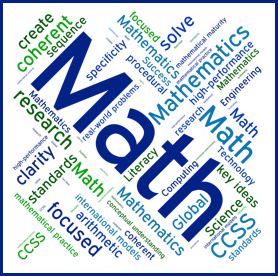
 |
STANDARD DESCRIPTION |
ACADEMIC VOCABULARY |
RESOURCES |
| NS.1—Apply and extend previous understandings of addition and subtraction to add and subtract rational numbers; represent addition and subtraction on a horizontal or vertical number line diagram.
NS.1.A—Describe situations in which opposite quantities combine to make 0. For example, a hydrogen atom has 0 charge because its two constituents are oppositely charged. NS.1.B—Understand p + q as the number located a distance |q| from p, in the positive or negative direction depending on whether q is positive or negative. Show that a number and its opposite have a sum of 0 (are additive inverses). Interpret sums of rational numbers by describing real-world contexts. NS.1.C—Understand subtraction of rational numbers as adding the additive inverse, p - q = p+ (-q). Show that the distance between two rational numbers on the number line is the absolute value of their difference, and apply this principle in real-world contexts. NS.1.D—Apply properties of operations as strategies to add and subtract rational numbers. NS.2—Apply and extend previous understandings of multiplication and division and of fractions to multiply and divide rational numbers. NS.2.A—Understand that multiplication is extended from fractions to rational numbers by requiring that operations continue to satisfy the properties of operations, particularly the distributive property, leading to products such as (-1)(-1) = 1 and the rules for multiplying signed numbers. Interpret products of rational numbers by describing real-world contexts. NS.2.B—Understand that integers can be divided, provided that the divisor is not zero, and every quotient of integers (with non-zero divisor) is a rational number. If p and q are integers, then -(p/q) = (-p)/q = p/(-q). Interpret quotients of rational numbers by describing real-world contexts. NS.2.C—Apply properties of operations as strategies to multiply and divide rational numbers. |
Additive Inverse
Integer Rational Number Absolute Value Number Line Difference Sum Opposites |
AIR Test (Ohio,
Florida, Utah, Arizona, Oregon, Washington, South Dakota, Idaho, Iowa)
Kuta Software Khan Academy JCESC Website
|
| NS.1.D—Apply properties of operations as strategies to add and subtract rational numbers.
NS.2.C—Apply properties of operations as strategies to multiply and divide rational numbers. NS.2.D—Convert a rational number to a decimal using long division; know that the decimal form of a rational number terminates in 0s or eventually repeats. NS.3—Solve real-world and mathematical problems involving the four operations with rational numbers. |
Rational Number
Terminating/ Repeating Decimal Fraction
Decimal
Numerator
Denominator
Complex Fraction Reciprocal |
AIR Test (Ohio,Florida, Utah, Arizona, Oregon, Washington, South Dakota, Idaho, Iowa)
Kuta Software Khan Academy JCESC Website |
| RP.1—Compute unit rates associated with ratios of fractions, including ratios of lengths, areas and other quantities measured in like or different units. For example, if a person walks 1/2 mile in each 1/4 hour, compute the unit rate as the complex fraction 1/2/1/4 miles per hour, equivalently 2 miles per hour.
RP.2—Recognize and represent proportional relationships between quantities. RP.2.A—Decide whether two quantities are in a proportional relationship, e.g., by testing for equivalent ratios in a table or graphing on a coordinate plane and observing whether the graph is a straight line through the origin. RP.2.B—Identify the constant of proportionality (unit rate) in tables, graphs, equations, diagrams, and verbal descriptions of proportional relationships. |
Unit Ratio
Ratio
Proportion Proportional Relationship Constant of Proportionality Each Equivalent Corresponding Sides Corresponding Angles Similar Figures Scale Right Triangles Special Quadrilaterals |
AIR Test (Ohio,
Florida, Utah, Arizona, Oregon, Washington, South Dakota, Idaho, Iowa)
Kuta Software Khan Academy JCESC Website
|
| RP.2.B—Identify the constant of proportionality (unit rate) in tables, graphs, equations, diagrams, and verbal descriptions of proportional relationships.
RP.2.C—Represent proportional relationships by equations. For example, if total cost t is proportional to the number n of items purchased at a constant price p, the relationship between the total cost and the number of items can be expressed as t = pn. RP.2.D—Explain what a point (x, y) on the graph of a proportional relationship means in terms of the situation, with special attention to the points (0, 0) and (1, r) where r is the unit rate. RP.3—Use proportional relationships to solve multistep ratio and percent problems. Examples: simple interest, tax, markups and markdowns, gratuities and commissions, fees, percent increase and decrease, percent error. |
Ordered Pairs
Origin Percent Equations Interest Rate % Change/Error Markup/Markdown Points for Constant of Proportionality |
AIR Test (Ohio,Florida, Utah, Arizona, Oregon, Washington, South Dakota, Idaho, Iowa) Kuta Software Khan Academy JCESC Website |
Please read the following before you begin:
1.) To avoid losing any work, make sure you click the SAVE button after each question.
2.) When you are finished with your assessment, click ALL FINISHED! REVIEW MY ANSWERS.
3.) When you are satisfied with your work, click LOOKS OK! SEND TO MY TEACHER.